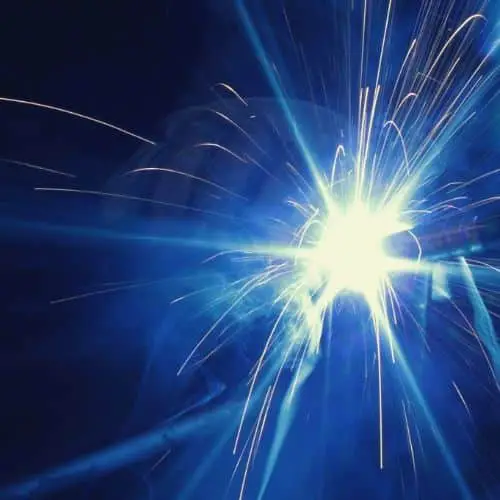
Arc welding is considered the most economical method of joining two pieces of metals. This method is using electricity to produce extreme heat, which helps to melt two parts of metal into one solid piece. Arc welders use a transformer or inverter-based power supply to produce an electric arc between ‘electrode’ or filler material and the base material, to create enough heat to melt the metals right at the contact point, making it efficient and precise.
Welding arc temperature usually ranges between 6000-8000 degrees Celcius which converted to Fahrenheit would be roughly between 10000-15000 degrees, but the exact temperature depends on a lot of factors like the current type, shielding gas type, amperage, etc. I am not a physicist so I can not explain it much more detail, however, we can look into some of the factors more deeply.
Welders use either direct – DC or alternating – AC current, as well as non-consumable or consumable electrodes depending on the method. And it is important to know that the welding area is always shielded by a protecting gas or with a cloud of flux created by some filler metals.
Sources of Power
Contents
Arc welding can utilize multiple sources of power supplies, but the most commonly used is the constant current power supplies (from the outlet in our wall) alongside with constant voltage power supply (from the machine) which is either direct – DC or alternating – AC current. The voltage is also directly related to the arc’s length, while the current to the amount of heat contribution.
In arc welding, constant current supplies are commonly used for manual welding methods such as shielded metal arc welding and gas tungsten arc welding as they maintain a uniform current despite the small variations of voltage. This feature is crucial because it can be quite tough to have a good grip on the electrode steadily in Stick welding, thus the arc length and the voltage will fluctuate often. On the other hand, constant voltage supplies maintain constantly the voltage while fluctuating the current, and for this reason, they are applied in automated arc welding processes on an industrial scale such as FCAW, submerged arc welding, and GMAW. In these welding processes, the length of the arc is kept constant because any variation in the length between the base material and the wire is immediately corrected by a huge current change. This means that if the distance between the base material and the wire is too short, the current will quickly increase, which increases the heat thus restoring it to its original separation distance.
At least that’s the theory.
In arc welding, the direction of the used current also matters and will affect the temperature of the welding arc, penetration, and quality of the weld depending on the material. Consumable electrode processes including gas metal arc and shielded metal arc welding use direct current, while the electrodes can be charged either negatively or positively.
Types of shielding methods affecting the arc temperature
As far as my intuition goes, the trimix (helium, argon, co2) or argon/CO2 or even pure co2 does not make a really big difference if you are welding fairly thin materials at home. Yes with the pure co2 you can get better penetration, meaning the arc is hotter, but the bigger difference comes to play when you are using the self-shielded filler metals with opposite polarity.
Welding Spatter temperature
Welding sparks are formed when the electrode is brought into contact with the workpiece then moved away, allowing air to be ionized between the two metals and electrons to jump across the gap. As a result, heat and bright light are generated. The temperatures of the welding spatter can range from 550 degrees to 1200 degrees Celsius.
Interesting read about welding spatter: Welding Spatter – 11 Things You Should Know About it
Conclusion
To sum it up, the heat of the welding arc is between 10000-15000 degrees, and because I am no physicist, I do not know the exact temperature and the exact impact of the different shielding gases, arc lengths, and amperage. It is almost impossible to determine that unless I would actually test it myself, but I think the range from 10000-15000 is enough to know that it is freaking hot.
